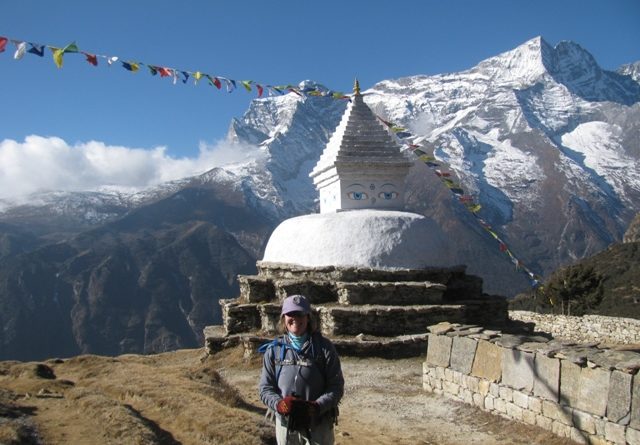Blessings in the Wind
By Sue McEvoy
Perhaps you saw your first set strung across a neighbor’s porch, colored squares of cloth, faded and tattered? Prayer flags, what do they mean? Maybe you enjoy skiing, and after ascending to the top of Highland Peak, found yourself looking upwards at strands of flags whipping in the wind at 12,392 feet?
Also known as Tibetan Prayer Flags, prayer flags trace their roots to ancient Tibet, Persia and China. Today, they are primarily produced in India, Nepal and Bhutan but make their way around the world as non-religious symbols promoting peace, compassion, strength and wisdom.
While there is no specific measurement for the rectangular squares, each set does follow a color order, yellow (earth), green (water), red (fire), white (air or cloud), and blue (sky or space). Each color represents one of the five basic elements in our physical world.
Traditionally, the flags are printed with ancient texts, mantras or sutras, as well as symbols. In the center is the Windhorse, combining the speed of the wind with the strength of a horse, a dragon, a tiger, a snow lion and a garuda (a wise eagle-like bird).
In Nepal, India and Bhutan, prayer flags are most often found on top of high passes, temples, rooftops and bridges, with the idea that the prayers are lifted by the wind and spread through the air (space) for the benefit of all beings.
My first experience of being immersed in a culture where prayer flags are a predominant feature of the landscape was trekking around Manaslu in 1999, the eighth highest peak in the world. Our group of eight women, organized by Julie Kennedy, included Molly Garland, Teresa Jennings, Karla Miller, Susie and daughter Jamie Godin, her friend Hilary and myself.
Trekking elevates hiking to a whole new status. We walked for a full 21 days. Morning tea was served as you sat in you’re sleeping bag; we had a team of young, and old, Nepalese men lined up each day to carry our belongings (packed in duffel bags), and a cook team prepared every breakfast, lunch and dinner, after setting up our tents.
Somewhere along the way, whether it was the camaraderie between us all, the jungle areas we crossed, the spectacular mountain views as we climbed higher, the successful crossing of Larkya – La (16,847 feet) our highest point, or the shared surrounding culture, I found “my place.”
Because not everyone with a job can afford to travel to regions like Nepal and India for five weeks at a time, I found myself dreaming of returning, but not seeing how to make it happen. In 2004, I signed up for a trip with the dZi Foundation, who were supplying volunteers to Global Dental Relief (GDR), in northern India.
Within two years time, I was hired as a Trip Leader with GDR, traveling to Leh, Ladakh, India, in the spring and the fall for four weeks at a time, with most of my expenses paid for. GDR brings teams of dentists, hygienists, and non-dental personnel to remote locations in India, Nepal, Kenya, Guatemala and Cambodia to provide free, much-needed dental care to impoverished children.
I had found my way! After six years of working the clinics at Leh, a gorgeous Buddhist enclave at 12,000 feet in the Indian state of Jammu/Kashmir, and four trips to the Taj Mahal, I was invited to be a trip leader at the clinics in Kathmandu, Nepal.
This was really a dream come true. Once or twice a year, spring or fall, to avoid the monsoon season, I lead trips for GDR — most of the time, tying in a trek or sightseeing adventure somewhere along the way. One of the GDR perks is side trips offered to the volunteers at the end of their two-week volunteer work time.
The Kathmandu clinic is always situated in Boudha, the Buddhist part of the city, and quite close to the Boudhanath Stupa, one of the largest in the world and a UNESCO World Heritage Site. The Stupa is renowned for the prayer flags stretched from its top, and the daily circumambulation of hundreds of Tibetans and lay people who come to make their own blessings to the wind.
The next time you see a string of prayer flags, no matter what your belief system, look up and watch as prayers are blown out into the wind, and know that you have received their blessings too. I know I will!
A resident of the Crystal Valley, Sue is most recognized for her “in-period” dress and style conducting tours of the Redstone Castle over a 20-year span. After a cancer diagnosis in August, she is focusing on her health and wellbeing, hoping to return to Nepal soon.


Bravo Seestah!! You are amazing???
Thanks for the enlightenment on prayer flags, but most of all your friendship for all these years. Brad